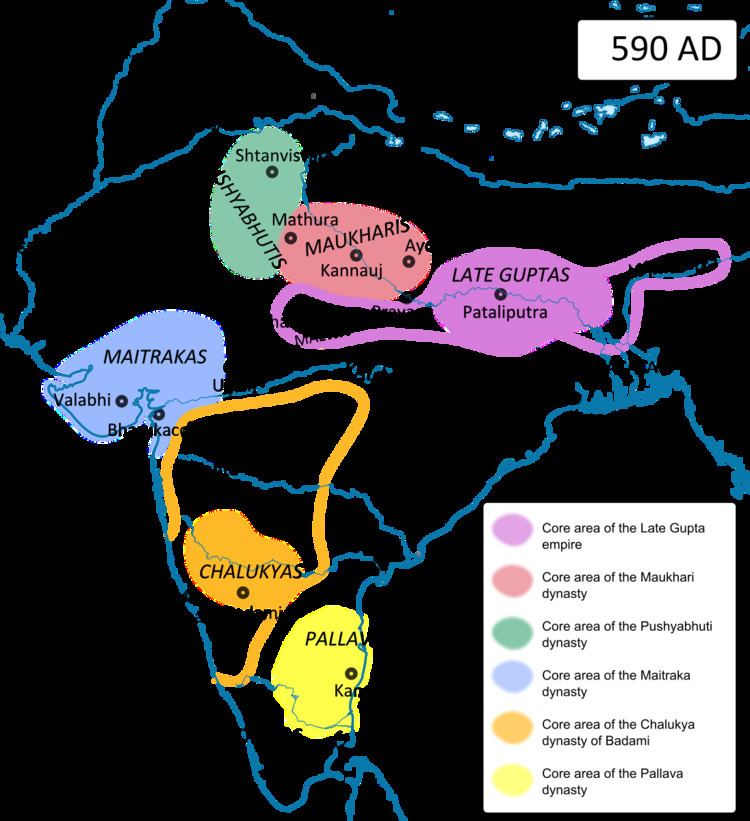Capital ThanesarKannauj Established 6th century | Government Monarchy Disestablished 7th century | |
 | ||
The Pushyabhuti dynasty (IAST: Puṣyabhūti), also known as the Vardhana dynasty, ruled parts of northern India during 6th and 7th centuries. The dynasty reached its zenith under its last ruler Harsha-Vardhana. At the height of Harsha's power, his Empire covered much of North and Northwestern India, extended East till Kamarupa, and South until Narmada River; and evenetually made Kannauj (in present Uttar Pradesh state) his capital, and ruled till 647 CE.
Contents
Origins
No concrete information is available about the origins of the dynasty. Harshacharita by the 7th century poet Bana gives a legendary account of their origin, naming Pushyabhuti as the dynasty's founder. According to this legend, Pushyabhuti lived in the Srikantha janapada (modern Kurukshetra district), whose capital was Sthanvishvara (modern Thanesar). A devotee of Shiva, Pushyabhuti became involved in a tantric ritual at a cremation ground, under the influence of Bhairavacharya, a teacher from "the South". At the end of this ritual, a goddess (identified with Lakshmi) anointed him the king and blessed him as the founder of a great dynasty.
The Pushyabhuti mentioned in Bana's account appears to be a fictional character, as he is not mentioned in the dynasty's inscriptions or any other source.
History
The Pushyabhuti dynasty originally ruled a small area around their capital Sthaneshvara (Thanesar). According to Hans T. Bakker, their ruler Aditya-Vardhana (or Aditya-Sena) was probably a feudatory to Sharva-Varman, the Maukhari king of Kannauj. His successor Prabhakara-Vardhana may have also been a feudatory to the Maukhari king Avanti-Varman in his early days. Prabhakara's daughter Rajyashri married Avanti-Varman's son Graha-Varman. As a result of this marriage, Prabhakara's political status increased significantly, and he assumed the imperial title Parama-bhattaraka Maharajadhiraja. ("the one to whom the other kings bow because of his valour and affection").
According to the Harshacharita, after Prabhakara's death, the king of Malava attacked Kannauj, supported by the ruler of Gauda. The Malava king killed Graha-Varman, and captured Rajyashri. Bana does not mention this king, but historians speculate him to be a ruler of the Later Gupta dynasty. Prabhakara's elder son Rajya-Vardhana defeated the Malava ruler, but was treacherously killed by the Gauda king.
The Harshacharita further states that Prabhakara's younger son Harsha-Vardhana then vowed to destroy the Gauda king and their allies. Again, Bana does not mention the name of the Gauda king, but historians identify him with Shashanka-Deva, a Maukhari vassal (mahasamanta). Harsha formed an alliance with Bhaskar Varman, the king of Kamarupa, and forced Shashanka to retreat. Subsequently, in 606 CE, Harsha was formally coronated as an emperor. He captured a large part of northern India (see the Empire of Harsha). He died without an heir, leading to the end of the Pushyabhuti dynasty.
Rulers
The following are the known rulers of the Pushyabhuti or Vardhana dynasty, with estimated period of reign (IAST names in bracket):
